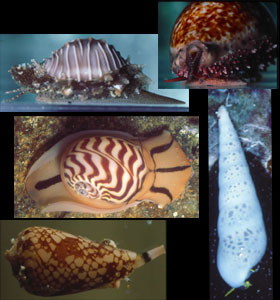Caenogastropoda

|
|
|
# of Described Species: First Appearance: Habitats: Marine, Freshwater, Brackish, and Terrestrial Shapes: Coiled snails, round snails, limpets, slugs, and more! Feeding Types: Grazers, carnivores, filter-feeders |
|

|
|
|
# of Described Species: First Appearance: Habitats: Marine, Freshwater, Brackish, and Terrestrial Shapes: Coiled snails, round snails, limpets, slugs, and more! Feeding Types: Grazers, carnivores, filter-feeders |
|
| Caenogastropoda is a very large, diverse group containing about 100 mostly marine families. Familiar groups include the littorines (Littorinidae), cowries (Cypraeidae), creepers (Cerithiidae, Batellariidae and Potamididae), worm snails (Vermetidae), moon snails (Naticidae), frog shells (Ranellidae and Bursidae), apple snails (Ampullariidae) and a large, almost entirely marine group of about 20 families that are all carnivores belonging to the clade Neogastropoda. These neogastropods include whelks (Buccinidae), muricids (Muricidae), volutes (Volutidae), harps (Harpidae), cones (Conidae) and augers (Terebridae). Caenogastropod shells are typically coiled, a few being limpet-like (e.g., the slipper limpets, Calyptraeidae). One family (Vermetidae) has shells resembling worm-tubes. While most caenogastropods possess a shell that encloses the animal, it is reduced in some and has become a small internal remnant in the slug-like Lamellariidae. Eulimidae are all parasitic on echinoderms, most being shelled ectoparasites but some have become shell-less, worm-like internal parasites. Some groups have invaded freshwater, the most important being the Viviparidae, Ampullariidae, Thiaridae (and several closely related families), and smaller-sized snails belong to the very diverse families Hydrobiidae, Bithyniidae and Pomatiopsidae. There are a few terrestrial taxa, the cyclophorids being the most significant family. | Caenogastropods were previously comprised of the "Mesogastropoda" and "Neogastropoda" within the "Prosobranchia". Of these two groups only the Neogastropoda remains as a monopyletic group. The shell is never nacreous and an operculum is present in adults. Apart from members of the Neogastropoda, the radula usually has only seven teeth in each row. The radula of neogastropods has five to one tooth in each row and is absent in some species. |


